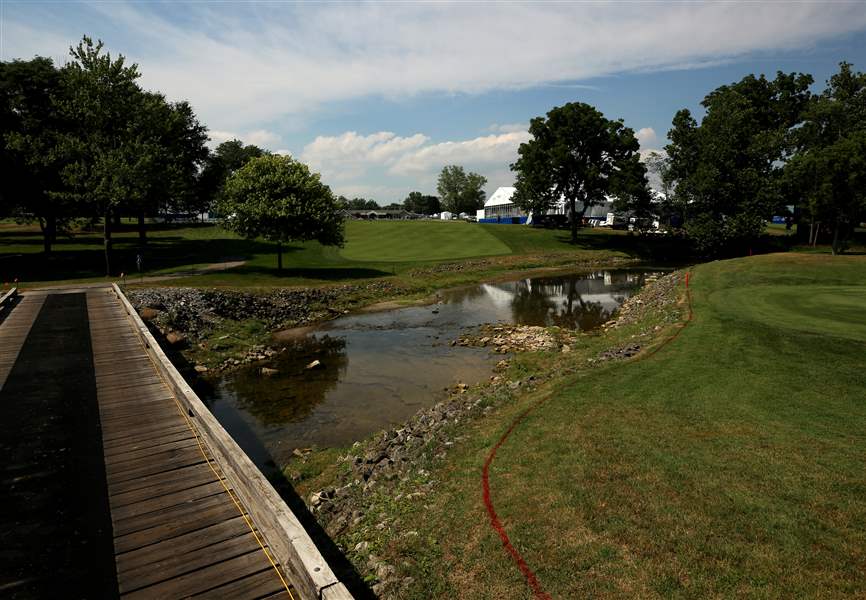
OUTDOORS
Something very fishy about this water hazard
7/10/2018
Ten Mile Creek makes a postcard quality run across the Highland Meadows course, creating a water hazard on a half dozen holes, and furnishing a home for a wide range of aquatic life.
Blade/Kurt Steiss

To the members who play this track on a regular basis, it sometimes is a dastardly troll that gobbles up pricey Callaway or Titleist golf balls that failed to hold the fairway, then refuses to give them back.
To the pros that will trek the 18-hole layout at Highland Meadows this week competing in the Marathon Classic, Ten Mile Creek is a water hazard, and a rather meek one because it rarely comes into play when the world’s best women attack the course.
Ten Mile Creek cuts a somewhat meandering diagonal across Highland Meadows before feeding its flow into the Ottawa River, which then wanders its way for almost 20 miles to a junction with Maumee Bay and Lake Erie. On the tournament adjusted course configuration, the creek comes into play on a half-dozen holes as it runs from the center of the western boundary of the property to the northeast corner, and a pesky ditch that cuts through the fairway of the tournament’s No. 9 hole eventually joins the creek.
Along its route through the course, Ten Mile Creek displays the classic features of a Great Lakes basin stream, with rocky riffles, long, smooth runs, and an occasional deeper pool where seasonal high water has carved into the creek bottom. Most of the waterway washes over the dolomite bedrock that is prevalent in the area, with chunk rock scattered about much of the creek’s course, providing surprisingly comfortable habitat for a range of species.
VIDEO: Ten Mile Creek is a home for wildlife at Highland Meadows
During a couple hours of fishing early one morning last week, I hooked six different species of fish in this ribbon of water, using ultralight spinning gear and a tiny jig. I also observed turtles and leopard frogs, saw an abundance of crayfish and mollusks, and the banks and sandbars dappled with the tracks of deer and raccoons. There were several sites where the raccoons had left a bit of a mess after some nocturnal dining on crayfish.
Mike Miller was a member at Highland Meadows for many years and still plays the course several times each season, and he said the creek and the course are home to a wide variety of wildlife.

“On the short par-3 across the creek, we would see a lot of turtles out there sunning themselves, and that was something I always looked forward to,” the local radio personality said. “There also were a lot of hawks flying around, maybe interested in the fish in the creek, and a bunch of deer hiding in the little patches of woods. With all of the other wildlife around, I’m not surprised there are fish in that creek, and I can say for certain there are a few of my golf balls in there too.”
RELATED: Marathon Classic field brings international flair to Toledo | Inside the nomadic existence of LPGA Tour equipment reps | ESPN’s Hannah Storm delivers keynote speech in Toledo | Lexi Thompson: Marathon Classic is 'one of our best tournaments' | Daycare allows LPGA Tour moms to concentrate on golf
The creek runs clear and healthy with little algae growth. The course superintendent Greg Pattinson said there is a conscious effort to keep the waterway clean and not fouled with excess fertilizer runoff. I saw very little debris, and not once was I plunked with a golf ball.
Green sunfish, bluegills, smallmouth bass, rock bass, creek chubs, and a common carp all took the bait offered by this rare intruder in their world. The fish preferred the darker stretches that were shaded by trees, bridges, or high banks. They also stationed themselves at the base of the runs where the faster water was funneled into a chute before spreading out into a deeper hole.
The creek is not open to fishing, even for members, because of safety concerns, but during a round of electrofishing and surveying a few years ago, biologists from the Ohio Environmental Protection Agency also found bluntnose minnows, fathead minnows, central stonerollers, redfin shiners, striped shiners, Johnny darters, orangethroat darters, and grass pickerel living in the creek.
“These are all pretty common small stream species in northwest Ohio,” said Bryan Kinter, fisheries biologist with the Ohio Division of Wildlife.
The staff at Highland Meadows also attested to the fact Ten Mile has occasional visits from northern pike and steelhead. Kinter said pike most likely would push into the creek in the spring, and the course staff noted a rogue steelhead or two arrive in the fall.
PHOTO GALLERY: Pre-LPGA Marathon Classic action
Ten Mile Creek actually extends more than 27 miles from its start west of State Route 109 and south of U.S. 20 in Fulton County, to its terminus at the Ottawa River. While appearing bucolic and melancholy most of the time, the creek can get ornery in a hurry when heavy rains change its demeanor.
Since its run across the Highland Meadows property is fairly short, Pattinson said what goes on upstream has the greatest impact on the course. Downpours upstream have scrambled the tournament schedule a time or two as the creek surged over its banks.
Contact Blade outdoors editor Matt Markey at: mmarkey@theblade.com, or 419-724-6068.